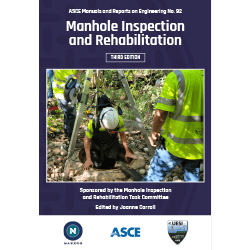Updated ASCE Manual of Practice 92 Provides Latest Guidance on Inspection and Rehabilitation of Manholes

Reston, Va. – ASCE’s Manual of Practice, Manhole Inspection and Rehabilitation, Third Edition, MOP 92, provides a valuable update to reflect current and complete inspection, as well as grading protocol that offers logical step-by-step guidance for maintaining and improving the longevity of manhole systems. This is a collaborative work by the Manhole Inspection and Rehabilitation Task Committee of the Pipelines Infrastructure Committee of the Pipeline Division of the Utility Engineering and Surveying Institute of ASCE in partnership with the Manhole Rehabilitation Committee of NASSCO.
Keys areas updated include:
- New chapter on wall thickness design for full-depth manhole rehabilitation,
- Information on standardization and NASSCO’s certification programs,
- Expanded content on various manhole rehabilitation methods and technologies, and
- New section detailing the importance of proper manhole inspection and rehabilitation.
MOP 92 is a valuable trenchless technology resource, assisting agencies in the proper identification of inventory and asset management, assessment and condition of manhole structures, decision-making regarding rehabilitation materials and methods, as well as providing key quality control measures when specifying the use of rehabilitation materials and technologies for manholes.
To purchase online visit the ASCE Bookstore
Limited review copies are available for book reviews. Please contact Leslie Connelly, [email protected].
About ASCE
Founded in 1852, the American Society of Civil Engineers represents more than 150,000 civil engineers worldwide and is America’s oldest national engineering society. ASCE works to raise awareness of the need to maintain and modernize the nation’s infrastructure using sustainable and resilient practices, advocates for increasing and optimizing investment in infrastructure, and improve engineering knowledge and competency.


